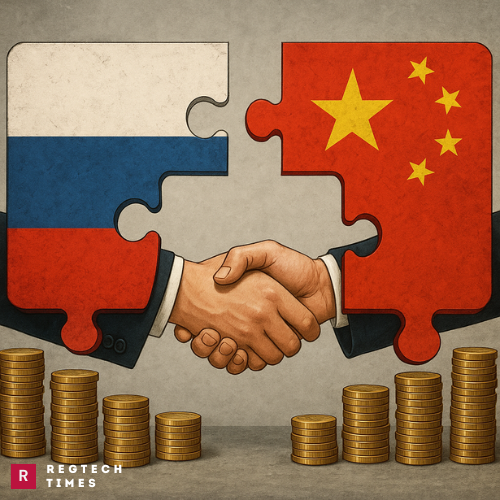Russia and China have quietly set up a new payment system to keep their booming trade away from Western regulators. This system, known among bankers as the “China Track,” helps the two countries do business together without being watched or blocked by Western countries like the United States. The goal is to avoid getting caught in a web of rules and punishments known as secondary sanctions.
Trade between Russia and China hit a record high of US$245 billion in 2024, despite serious problems with payments. Some Chinese banks, afraid of upsetting the U.S., had backed off from doing business with Russia. This caused delays and huge fees—sometimes as high as 12%—just to send money.
To solve this, major Russian banks created a special way to handle payments. Instead of using regular systems like SWIFT, which are monitored by the West, they now run payments through a network of middlemen located in countries friendly to Russia. These banks don’t want their names revealed because they are already under sanctions, but sources say they’re among Russia’s top 20 largest banks.
Critical Shift: China Builds Swift Alternative CIPS Amid Sanctions Fears
How the China Track Works
Here’s how the “China Track” operates: Russian banks now manage payments through several agents. Some handle imports (things Russia buys), and others handle exports (things Russia sells). These agents are verified and trusted by the banks.
All the payments from different deals are then added up and balanced, or “netted,” inside each bank. This means instead of sending each payment separately, they calculate the difference between what is owed and what is received. After balancing everything, the banks send the final amounts to each party involved. It’s like a big math problem that gets solved all at once instead of through many small steps.
What makes China Track system especially powerful is that it doesn’t use Western banks or messaging systems. This makes it hard for foreign countries to block or track the money. The banks also offer guarantees to make sure everyone gets paid and add financial protections in case someone fails to deliver.
Currently, these clearing sessions—where payments are settled—happen once a week, every Thursday. There are plans to hold them twice a week soon, because more companies want to use the system.
Secure, Cheaper, But Not Perfect
For businesses that can access it, the “China Track” system offers big savings and more security. Before, companies were paying up to 12% in fees. Now, under this system, they only pay around 1% for imports and just 0.5% for exports. This makes it the cheapest way to move money between the two countries today.
Cut Off from SWIFT, Russia Turns to Tokens and Stablecoins for Trade Lifeline
But the system isn’t perfect. Every single payment needs approval, which can slow things down. Also, it doesn’t work well with some of Russia’s tax rules, especially when it comes to getting back value-added tax (VAT). Still, companies say it’s worth it because they know their money won’t be frozen or sent back.
This new system mostly works with 11 provinces in China, which are the main suppliers of goods sent to Russia. As long as the items being traded aren’t under sanctions and the Chinese company is based in one of these provinces, the payments go through quickly—usually within two days.
Even though the system is being kept quiet, it’s been running for a while without any major problems. Bankers involved in the process say that 100% of the payments made so far have gone through without issues.
SWIFT Dispute Exposes Growing Divide Between U.S. and EU on Russia Sanctions
This setup has helped keep Russia’s trade with China alive even as other countries have tried to slow it down. By building a pathway that avoids the usual channels, Russia and China have found a way to quietly continue doing business together—even under intense pressure from the outside world.


